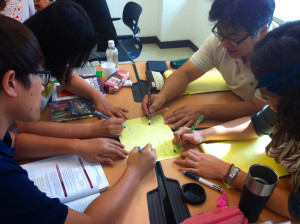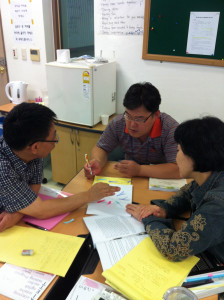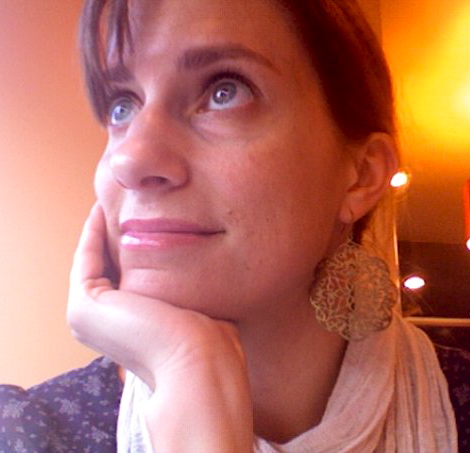Critical thinking in Korean education by Josette LeBlanc
“How do you feel about learning how to write during this program?”
This is the question I ask each new English teacher who enters our in-service teacher training program. For the next five months not only will I be their trainer, I will also be their writing teacher. Without fail, the most common answer I get from these teachers ranging from age 27 to 52 is:
“I’m nervous because I haven’t learned how to write. Not even in Korean. I don’t know how to organize my ideas.”
You can imagine how compounded this anxiety gets when they start thinking about how they will have to start teaching writing in the next few years. These worries are completely understandable. Not only do most of these teachers teach to a test that promotes memorization, they were also raised in this system. In Korea, the College Scholastic Aptitude Test (CSAT), or suneung (수능), is king. It is the culmination of countless hours of rote learning, and your score determines if you will enter a university worthy of embarrassment or praise. In a country that honors such a pedagogical system, most educators have a hard time finding room for engaging their students in critical thinking: the process of observing, analyzing or questioning, and finally of coming to your own conclusions. And from what the teachers’ answer to my question about writing tells me, they might not even know where to begin.

I think there is great value in expressing what one thinks, in writing or otherwise. When we are given the chance to question and explore, we get a little closer to understanding ourselves and the world. Through this understanding we are better equipped to make decisions that will contribute to our happiness and to the well being of others. When I hear about the school violence or teen suicides in Korea, I wonder how a system that suppresses creative thought and glorifies competition contributes to these horror stories. (See Curtis Porter’s post, School Violence in Korea, for more on this topic.) I also wonder what a little more space for critical and creative thinking might do for these students.
This is the space our program tries to guide the teachers through. In writing class they analyze genres and different organizational patterns such as short stories, narratives or argumentative essays. Collaboratively, they discuss and debate topics that hit close to home: Should corporal punishment be banned from schools? Should English be removed from the CSAT? What would your dream school look like? The teachers explore grammatical or lexical structures that will help them express what they want to say. They go through the writing process. In the end, the majority of them are successful in organizing their ideas into a text I believe is quite powerful.
At the end of the five months, what they have to say about writing is along these lines:
“Not only have I learned how to write, I have learned how to think. It was a wonderful experience to think about myself as a teacher and as a person. I feel more confident about myself as a teacher and writer.”

There is no greater gift than knowing the pleasure and empowerment they got from exploring their thoughts. It gives me hope for their future and for the future of their students.
For many of these teachers, this writing experience becomes a faint memory, drowned in the test-focused system. However, some have managed to convince their principals to allow them to teach after hours writing classes. A rare few have even implemented writing skills in their curriculum. Perhaps writing itself does not always equal critical thinking, but it is a first step. I know these teachers are trying to give their students a voice. They recall the feelings they had about writing and they want their students to feel the same. I am excited to see where these seeds of thought will spread.
For more on the topic of critical thinking in Korean education, I recommend these links and articles:
- The blog of Curtis Porter, professor of the Critical Pedagogies course at Dankook University TESOL Graduate School
- Thinking Critically by iTDi mentor, James Taylor
- Why Has the Critical Thinking Movement Not Come to Korea?; article by John Michael McGuire
- Exploring the Possibilities for EFL Critical Pedagogy in Korea: A Two-Part Case Study; article by Shin HyunJung and Graham Crookes


Dear Josette,
Thanks for sharing your clear ideas about what critical thinking is. Yet, I have some questions. If the Korean Educational system is focused on memorisation, and as far as I could read after your post, even physical punishment is somehow allowed in the class, I wonder how you manage to challenge the system.
Critical thinking open the doors to freedom, and new discoveries. How does your work fit into the system? I imagine your learners could feel even scared at times, when they were not brought up in freedom of thought, when mistakes are not allowed, this might be the root to this dreadful issue of violence and even teen suicide.
I also want to thank you for helping me learn a little more about reflection and writing. Sometimes my ideas come to me like falls, I get flooded with ideas, and I find it really challenging to find some kind of logical order to finally come up with my reflections, must admit it also happens when I plan my lessons. In a extreme desire to give my learners the best I can I realise they must feel overwhelmed at times. But I as I become aware of this, I feel I am moving forward to find a way to work it out.
Thanks Josette, you have helped me a lot.
Dear Debbie,
Thank you, as always, for reading and leaving your thoughts and questions. A dialogue with you is always a gift.
Before I attempt to answer your question, I should clarify something. Corporal punishment is officially banned in the Korean school system. When the teachers write about this topic, they are in a sense reflecting on a time prior to it being banned and either agreeing or disagreeing with that policy. I’ve written a few posts on my blog about some things the teachers have reflected in essays or other forms of text: http://tokenteach.wordpress.com/2012/09/23/the-love-stick-that-motivates/ and http://tokenteach.wordpress.com/2012/09/26/the-difference-between-love-and-a-stick/
That being said, I have heard from some teachers around the peninsula that teachers are still using the “love stick” or other similar ways of “reinforcing” rules.
And how do we challenge the system? You empathize correctly when you imagine that the teachers must be scared at times. This is why I do my best to give the teachers a voice, a place to express their fears. I’ve come to learn that teachers are in desperate need of support in systems such as these. They often feel alone and unsupported. If I can give them a small place to share their feelings and ideas, I know I am doing a small part. I also realize that this in itself can be scary. When we air our true feelings, we also have to face what is. Sometimes it’s just easier to stay hidden. All I know is that in my experience with conflict and hardship, true healing comes when we can face the problem.
In relation to writing, I really connected to what you had to say about finding logical order to planning lessons. It seems you are starting to find a way out of the fog. I am very happy to see you celebrating the small steps. I also feel the fog at times, and it is at those times that I realize I need to take out my poster paper and start writing my ideas. This is the only time my thoughts start making sense: when I can see them on paper.
Thank you for giving me the chance to go deeper into my thoughts Debbie! You have also helped me a lot!
Josette
Dear Josette,
Bravo! I also read your posts on “love stick” and the comments your visitors made. You are certainly a great role model for making steps towards a better world. I am sure these teachers value the power of love and respect in education, they are developing in a positive environment.
Thanks so much dear teacher.
Debbie
I truly appreciate your perspective Debbie. You brought a little more brightness to my day. Thank you for keeping the cycle of positivity and care alive. 🙂
Josette
Yes I am commenting on my own post. 🙂 I read this feedback this morning from one of our teacher-trainees, and I want to share it here for all of us to share and celebrate.
“During reading and writing classes, I feel that I am developing power of thinking rather than power of memorizing. I brainstorm, share and discuss ideas and opinions in pair or group works, sometimes with mingling activity. And the procedure is done in a method of scaffolding and it makes students learn more easily.”
Small steps. 🙂
Oh, how I identified with this post. As someone who used to teach reading and writing in a teacher training institute in South Korea, I’m beginning to think you wrote this specifically for me!
As you know from my own blog post which you kindly linked to, I had something of a steep learning curve in discovering the critical thinking gap in my Korean teacher students. Unfortunately I didn’t have time to really develop this, as I left the country too soon to take it further. It’s great to see how you have deliberately set out to improve these skills which I think are fundamental, and increasingly important in the modern world.
Hello James,
I was so happy to read about how this piece connected to you. I was so grateful to find your blog post as it served as great inspiration. It also helped me realize that my audience was already out there as you say. 🙂
I know there is so much more that I could do in relation to this topic and teaching about critical thinking. This post has given me the push to investigate it further. I plan to interview some of the teachers in this program about how writing has influenced their thinking process. One teacher has already agreed to meet with me. I’m quite excited about that.
Thank you for your support James!